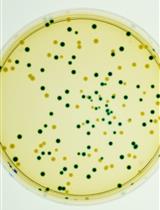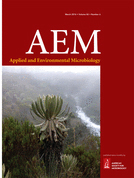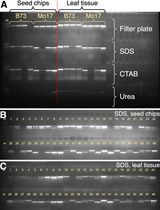- EN - English
- CN - 中文
Endophytic Microbial Community DNA Extraction from the Plant Phyllosphere
从植物叶际提取内生菌微生物群落DNA
发布: 2017年02月20日第7卷第4期 DOI: 10.21769/BioProtoc.2142 浏览次数: 11676
评审: Ramalingam BethunaickanAnonymous reviewer(s)

相关实验方案

基于β-葡萄糖醛酸酶 (GUS) 的细菌竞争测定以评估植物感染期间适应性的细微差异
Julien S. Luneau [...] Alice Boulanger
2022年07月05日 3143 阅读
Abstract
The plant phyllosphere, which represents all plant parts that are above the ground, is considered one of the most extensive ecosystems to be colonized by microorganisms, both at the surface as epiphytes or as endophytes within the plant. These plant-associated microbial communities are reservoirs of microbial diversity and they can be important for plant health. The characterization of microbial communities in diverse plants, such as Espeletia plants that are endemic to the Paramo ecosystem in the Andes Mountains, can shed light regarding possible interactions among microorganisms and microbial functional properties. Obtaining DNA from plant endophytic microbial communities involves various steps to ensure that samples are free of contamination from microorganisms present on the plant surface (epiphytes). Plant leaves are first surface sterilized, cut into pieces, homogenized using glass beads, and then used for DNA extraction using a commercially available kit. DNA samples are then quantified and analyzed using Qubit® 2.0 for use in PCR amplification of 16S rRNA genes.
Keywords: Endophyte (内生菌)Background
Extraction of endophytic DNA from plant samples has been done by several research groups and usually involves steps to minimize contamination from surface microbes. However, protocols must also be adapted to the plant material being studied and as such can incorporate different steps. Extraction of epiphyte DNA must also ensure that there is no contamination from endophytic microorganisms. The protocol described integrates elements from previous reports (Miles et al., 2012; Araujo et al., 2002), but was not identical given the characteristics of the plant material used. In this work we used leaves from Espeletia hartwegiana, a plant that is endemic to the Paramo ecosystem present in the Colombian Andean mountains. These leaves are characterized to be large and succulent with the presence of short hairs on the surface (pubescence) that require removal prior to leaf surface sterilization and DNA isolation. Here, although the pubescence is removed, the microorganisms associated with it are dislodged first to ensure a complete picture of the epiphyte community. In this case, sufficient DNA of good quality was recovered for PCR amplification and 16S rRNA gene analysis and for functional analysis using the GeoChip (Yan et al., 2015). Nonetheless, other downstream applications could require more DNA and hence more plant material.
Materials and Reagents
- Gloves
- 1.5 ml sterile microcentrifuge tubes
- 10, 100, 1,000 micropipette tips
- Sterile craft paper
- Ziploc bags (ethanol rinsed)
- Sterile swabs (preferably sponge top)
- Plant leaves (Espeletia sp.) ~10 g (Maybe more depending on the downstream application). Leaves were collected 1-2 days prior to processing, transported on dry ice and stored in sterile plastic bags at 4 °C
- Sterile dH2O
- 100% ethanol (Sigma-Aldrich, catalog number: E7023 )
- 5.25% sodium hypochlorite (Quidiscol Ltda, Bogotá, Colombia)
- Power Soil DNA Isolation Kit (MO BIO Laboratories, catalog number: 12888-50 )
- Sodium phosphate dibasic, Na2HPO4 (Sigma-Aldrich, catalog number: S3264 )
- Malt extract solid medium (OXOID, catalog number: CM0059 )
- Tris base (Promega, catalog number: H5133 )
- EDTA (Sigma-Aldrich, catalog number: E9884 )
- HCl (Mol Labs, catalog number: V4653 )
- 0.5 M NaH2PO4 (see Recipes)
- NAP buffer (see Recipes)
- Malt extract solid medium (see Recipes)
- TE buffer (see Recipes)
Note: All reagents used have a specific manufacturer and catalog number. Nonetheless, the user can use any molecular-grade reagent for the protocol.
Equipment
- Sterile 500-1,000 ml beakers, autoclaved
- 1-25 µl micropipette
- 10-100 µl micropipette
- 100-1,000 µl micropipette
- Sterile razors
- Vortex
- Sterile tweezers
- 25 °C incubator
- Sterile glass beads, autoclaved
- Laminar flow hood, preferably a class II BSC to avoid contamination
- Mini-Bead beater-96 (BioSpec Products)
- Qubit® 2.0 fluorometer (Thermo Fisher Scientific, USA)
- Autoclave
Procedure
文章信息
版权信息
© 2017 The Authors; exclusive licensee Bio-protocol LLC.
如何引用
Ruiz-Pérez, C. A. and Zambrano, M. M. (2017). Endophytic Microbial Community DNA Extraction from the Plant Phyllosphere. Bio-protocol 7(4): e2142. DOI: 10.21769/BioProtoc.2142.
分类
植物科学 > 植物生理学 > 胞内共生
微生物学 > 微生物-宿主相互作用 > 细菌
分子生物学 > DNA > DNA 提取
您对这篇实验方法有问题吗?
在此处发布您的问题,我们将邀请本文作者来回答。同时,我们会将您的问题发布到Bio-protocol Exchange,以便寻求社区成员的帮助。
Share
Bluesky
X
Copy link











